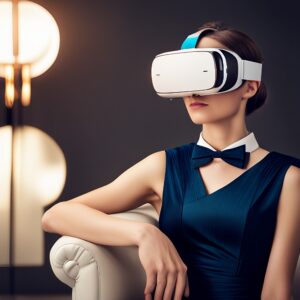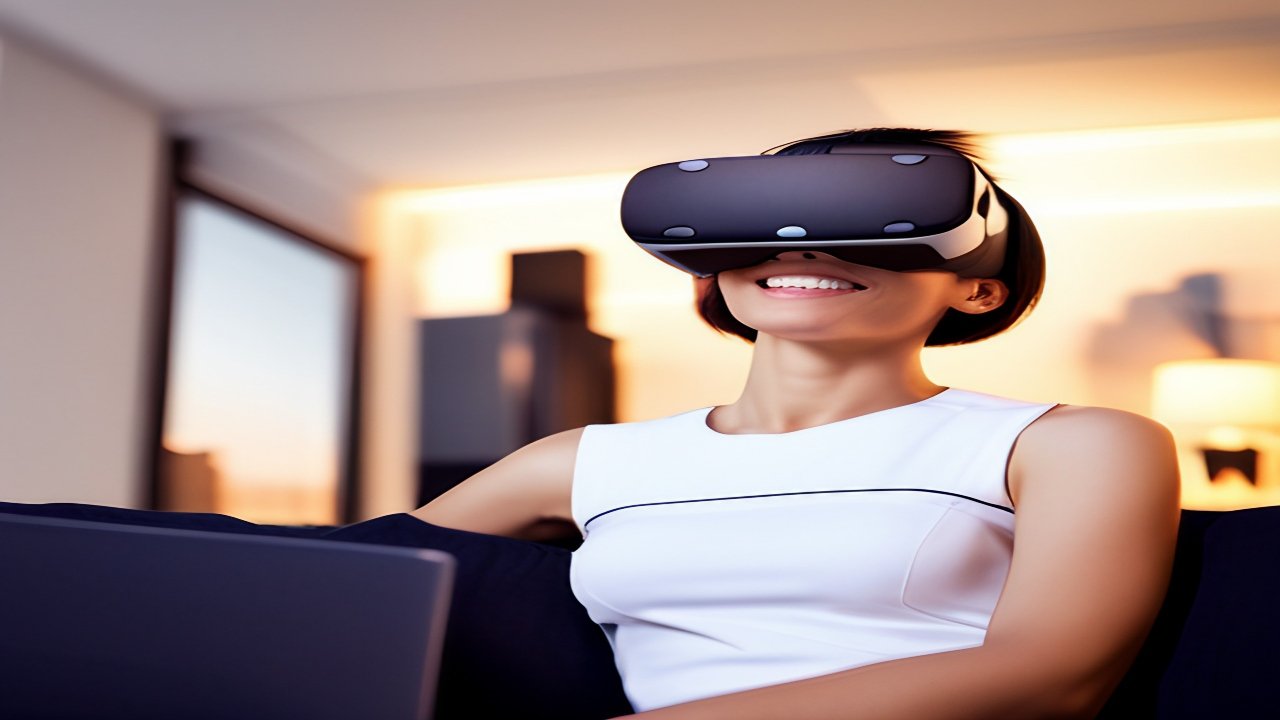In recent years, more and more people have become interested in the potential of VR. But what does it mean to experience a ‘virtual world’? With technological advancements becoming increasingly accessible for both consumers and businesses alike, now is the perfect time to take a deep dive into exploring Virtual Reality (VR): its definition, application in various spheres such as gaming or training scenarios; implications for industries across various sectors; best practices when incorporating VR solutions into daily workflows. In this blog post, we will discuss these topics while aiming to answer questions such as “Virtual reality; what is it” and “How does it work?” Get ready to take your knowledge even further by advancing together on this quest!
What is Virtual Reality?
Virtual reality (VR) is a term referring to a computer-generated environment that immerses users in a simulated world.
This fully immersive virtual reality technology leverages computer graphics to create a digital space where users can interact with virtual objects and environments.
VR headsets, like the Oculus Rift or HTC Vive, are essential components that track your movements and display the virtual world in front of your eyes, providing a sense of presence within the virtual environment.
How Does Virtual Reality Work?
Virtual reality technology works by combining specialized VR headsets with computer-generated environments.
These VR headsets, equipped with sensors and displays, track your head and body movements, ensuring that as you move, the virtual world moves accordingly, creating an immersive experience.
Computer graphics play a pivotal role, rendering lifelike visuals and simulating interactions with virtual objects.
This seamless integration of hardware and software creates the illusion of being inside a different reality, enriching your senses and perception.
What Are the Different Types of Virtual Reality Headsets?
There are several types of virtual reality headsets, ranging from fully immersive VR to more accessible options:
Fully Immersive VR Headsets:
These offer the highest level of immersion, with devices like the Oculus Rift and HTC Vive.
Semi-Immersive VR Headsets:
Examples include the PlayStation VR and Oculus Quest, providing a compromise between immersion and affordability.
Non-Immersive VR Headsets:
These are simpler, often using mobile phones for VR experiences.
Mixed Reality Headsets:
Devices like Microsoft HoloLens blend virtual and real-world elements, bridging the gap between augmented and virtual reality.
What Are the Benefits of Using Virtual Reality?
Virtual reality offers numerous benefits, such as:
- Immersive Learning: VR can simulate real-world scenarios for training and education.
- Therapeutic Applications: It aids in pain management, exposure therapy, and rehabilitation.
- Entertainment: VR gaming and experiences provide unique, engaging entertainment.
- Virtual Meetings: VR facilitates virtual meetings and collaborations, enhancing remote communication.

What Are the Risks of Using Virtual Reality?
While VR offers exciting possibilities, it also carries some risks, including:
- Motion Sickness: Some users may experience motion sickness due to the disparity between visual and physical motion.
- Eye Strain: Prolonged use can cause eye strain and discomfort.
- Isolation: Excessive use may lead to social isolation as users disconnect from the real world.
- Cybersecurity: Security risks may arise when interacting in virtual environments or sharing personal information.
How Can I Stay Safe While Using Virtual Reality?
To stay safe while using virtual reality, consider these precautions:
- Set Time Limits: Avoid prolonged VR sessions to prevent discomfort and isolation.
- Take Breaks: Regularly rest your eyes and stretch to reduce eye strain.
- Create a Safe Space: Ensure your physical environment is clear of obstacles to prevent accidents.
- Use Trusted Sources: Download content and apps from reputable sources to avoid security risks.
What Are Some of the Most Popular VR Games and Experiences?
Some popular VR games and experiences include:
- Beat Saber: A rhythm-based game where you slice through beats with lightsabers.
- Half-Life: Alyx: A highly immersive first-person shooter set in the Half-Life universe.
- Superhot VR: A unique shooter game where time moves only when you move.
- Moss: An adventure game starring a tiny, heroic mouse.
How Can I Create My Own VR Content?
To create VR content, you’ll need:
- VR-Compatible Software: Use software like Unity or Unreal Engine for game development or 3D modeling programs for 360-degree videos.
- VR Headset: Own a VR headset for testing and experiencing your creations.
- Coding Skills: Learn programming languages like C# or C++ for interactive experiences.
- 3D Modeling Skills: For creating virtual objects and environments.
What Are Some of the Challenges of Virtual Reality Experiences?
Challenges in virtual reality experiences include:
- Motion Sickness: Developers must design experiences to minimize motion sickness.
- Hardware Requirements: VR can be demanding on computer hardware, making it less accessible.
- Content Development: Creating high-quality VR content requires specific skills and resources.
- Cost: High-quality VR headsets can be expensive, limiting widespread adoption.
What Are Some of the New and Emerging Technologies in VR?
Emerging VR technologies include:
- Hand Tracking: Gesture recognition allows users to interact with virtual environments without controllers.
- Eye Tracking: Enhanced interaction and more realistic avatars through eye movement detection.
- Wireless VR: Eliminating cables for greater freedom of movement.
- Augmented Reality Integration: Blending VR and AR for mixed reality experiences.
How Can VR Be Used to Improve Our Lives in the Real World?
VR has real-world applications, such as:
- Medical Training: Simulating surgeries and medical procedures for training.
- Architectural Visualization: Designing and presenting architectural projects in 3D.
- Therapy and Rehabilitation: Assisting patients in physical and psychological therapy.
- Virtual Tourism: Providing immersive travel experiences and cultural education.
What Is the Future of Virtual Reality?
The future of virtual reality holds exciting potential, including:
- Advanced Hardware: Smaller, more powerful, and affordable VR headsets.
- Expanded Content: A broader range of VR experiences, from education to entertainment.
- Integration with the Real World: Further blending of virtual and real environments.
- Social VR: Enhanced virtual social interactions and collaborations.
- Commercial and Industrial Adoption: Widespread use in various industries for training, design, and more.
What Are Some Popular VR Games?
Popular VR games include “Beat Saber,” known for its rhythm-based gameplay, and “Half-Life: Alyx,” praised for its immersive storytelling.
“Superhot VR” offers a unique time-based shooting experience, while “Moss” stands out as a charming adventure game. These titles showcase the diversity of experiences available in the virtual reality world.
Who should not use virtual reality?
Virtual reality is an incredible technology that immerses users in computer-generated environments, blurring the line between the physical and virtual worlds.
However, it’s crucial to acknowledge that not everyone should dive into the virtual realm. People with a history of epilepsy or seizures should avoid VR due to the potential triggers of visual stimuli.
Similarly, individuals with certain psychological conditions, like severe anxiety disorders, may find the intense immersion unsettling.
Pregnant women should also be cautious as there’s limited research on the effects of prolonged VR exposure on developing fetuses.
What are the very real dangers of virtual reality?
While virtual reality offers exciting experiences, there are genuine risks associated with its use.
Extended periods of VR immersion can lead to a phenomenon called “virtual reality motion sickness,” causing symptoms like nausea and disorientation.
Spending excessive time in VR can lead to social isolation, as users disconnect from the real world.
Overuse may also impact physical health, contributing to sedentary behavior and potential musculoskeletal issues. It’s essential to strike a balance and practice responsible usage to mitigate these dangers.
How does VR affect the brain?
Virtual reality technology can profoundly impact the brain. When immersed in a virtual environment, the brain perceives the computer-generated world as real, triggering sensory and cognitive responses.
This can lead to an enhanced sense of presence and immersion. However, prolonged VR use may strain the brain, causing symptoms like VR-induced motion sickness and cognitive fatigue. On the positive side, VR can be used for therapeutic purposes, helping individuals with conditions like PTSD or phobias gradually desensitize to triggers.
How long should you be in VR?
The ideal duration for VR usage varies from person to person. It’s essential to listen to your body and mind.
Generally, it’s recommended to start with short sessions of 15-30 minutes, gradually increasing as you become accustomed to virtual reality.
Frequent breaks are crucial to prevent VR-induced motion sickness and cognitive fatigue.
Striking a balance between real-world and virtual experiences is key to avoiding potential negative effects associated with excessive VR use.
Is VR good for Mental Health?
Virtual reality has shown promise in enhancing mental health in specific contexts. Therapists and researchers have utilized VR to treat conditions such as anxiety, PTSD, and depression.
Virtual reality exposure therapy allows patients to confront their fears in a controlled environment.
However, it’s essential to use VR for mental health under professional guidance. On the flip side, excessive use of VR for escapism can have detrimental effects on mental health, contributing to social isolation and disconnection from reality.

Is VR even worth it?
Whether VR is worth it depends on your interests and needs. Virtual reality headsets and systems vary in cost, with prices ranging from a few hundred to over a thousand dollars.
If you’re an avid gamer or enthusiast looking for immersive experiences, VR can be a worthwhile investment.
Industries like education, healthcare, and training have embraced VR for its potential to revolutionize learning and skill development.
However, if you’re unsure about its value to you, consider trying VR at a friend’s or in a demo before making a decision.
How much does a VR headset cost?
The cost of a VR headset varies based on the brand, features, and technology involved. Entry-level VR headsets, like the Oculus Quest, can start at around $299, offering a wireless, standalone experience.
Mid-range VR headsets with more advanced features and higher-quality displays typically range from $400 to $800.
High-end VR systems, such as the HTC Vive Pro or Valve Index, can exceed $1,000 when factoring in accessories and compatible gaming hardware. It’s essential to research and choose a headset that aligns with your budget and desired VR experiences.
Does anyone actually use VR?
Yes, virtual reality has gained traction and is being used across various sectors. Gamers are a significant user base, enjoying immersive gaming experiences.
However, VR extends beyond gaming, with applications in education, healthcare, architecture, and workforce training. It’s also used for virtual meetings and remote collaboration, especially in a post-pandemic world.
The adoption of VR continues to grow as the technology evolves and becomes more accessible, making it an exciting frontier in the digital landscape.
Is VR like real life?
Virtual reality strives to create immersive experiences, but it’s important to note that it’s not a perfect replication of real life.
VR offers a computer-generated environment that can be incredibly convincing but lacks the full spectrum of sensory input present in the physical world.
While VR can be highly realistic, it may not match every aspect of reality. Users should be aware of this distinction to manage expectations and make the most of the unique opportunities that virtual reality offers in bridging the gap between the virtual and physical worlds.
Bottom line:
Virtual reality is a rapidly growing technology that offers both exciting opportunities and potential risks.
As with any new technology, responsible usage is key to making the most of its benefits while avoiding its dangers.
Whether you’re a gamer, enthusiast, or professional considering investing in VR, it’s essential to understand the possible implications and use it mindfully.
With time, research, and advancements in the field, virtual reality has the potential to enhance our lives in numerous ways.




